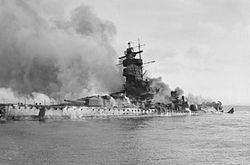This article needs additional citations for verification .(August 2007) |
| Operation Pelikan | |
|---|---|
| Part of the American Theater of World War II | |
 A schematic of the Panama Canal, illustrating the sequence of locks and passages. | |
| Location | |
| Planned by | |
| Objective | Sabotage of the Panama Canal |
| Date | 1943 |
| Outcome | Aborted |
Operation Pelikan (German : Unternehmen Pelikan), also known as Projekt 14, was a German plan for crippling the Panama Canal during World War II. In mid-late 1943 the Wehrmacht had completed preparations to haul two Ju 87 Stukas with folding wings on two U-boats to an unnamed Colombian island near the coast of Panama, reassemble the planes, arm them with "special bombs", and then send them to attack the Gatun Dam. After completing the mission, the pilots would fly to a neutral country and seek internment. However, Germany called off the plan, for unknown reasons, at the last minute. Rumors among the Germans who planned the sabotage were that it had been called off due to betrayal.
Most of these types of plans involved acts of sabotage using agents in place and/or landed by U-boat. [1]
